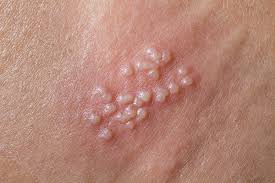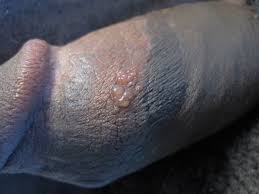

Sexually transmitted viral infection affecting the genital or surrounding areas.
The main virus responsible is the herpes simplex virus 2 (HSV-2).
Small percentage of cases caused by herpes simplex virus 1 (HSV-1) in the past,and now makes up an estimated 50% or greater of new infections among some populations, such as college students and heterosexual women.
HSV-1 is an increasing cause of genital herpes, especially in high income countries that have a declining rate of oral HSV-1 acquisition during childhood, leaving individuals susceptible at initiation of sexual activity.
An epidemiological transmission of HSV-1 from oral to general infection is predicted, with up to 25% of our HSV-1 acquisitions in the genital tract by 2050 in the US.
in 2018 18.6 million people in the US were estimated to have genital HSV-2infection.
The burden of genital herpes is primarily borne by women, who comprise 65% of prevalent, genital herpes infections in the US and worldwide.
Genital HSV –1 shedding is frequent after the first episode and declines rapidly during the first year of infection.
Viral shedding as detected of herpes simplex virus from skin and mucosal surfaces of courage during genitalg herpes, recurrences, may occur intermittently in the absence of genital ulcers, and may be transmitted during sex and childbirth.
Herpes Simplex virus infections are characterized by recurrent, self limited genital ulcers and is associated with large medical, social, and financial burdens.
Shedding with HSV-2 is significantly greater than associated with a higher percentage of symptoms.
Asymptomatic shedding is common and unpredictable in HSV-1.
Seroprevalence of HSV-2 infections are decreasing in the US.
The infection can be transmitted from individual to individual, most often because of asymptomatic viral shedding.
HSV is a common cause of neonatal infections and can be due to either HSV- 1 or HSV – 2.
Neonatal herpes occurs in approximately 10 to 31.5 newborns per hundred thousand live births in the US and is typically acquired by exposure to HSV –1 or HSV-2 during vaginal delivery.
Herpes may cause skin, and mucus membrane infection, encephalitis, neurodevelopmental defects or disseminated infection associated with a 40% neonatal mortality rate.
The reservoir of individuals infected with HSV is increasing.
25% of incident HSV-1 infections in the 15 through 49 year age group are estimated to be genital and approximately 85% are presumed due to oral-genital transmission.
Among women, men and transgender women who have sex with men HSV-1 is a more common cause of genital herpes than HSV-2.
HSV-2 predominantly is an anogenital pathogen whereas HSV-1 also causes or0labial disease.
Pre-existing HSV-2 infections may provide some protection against acquiring new HSV-1 infections, where is pre-existing HSV-1 infections may decrease the probability of new symptomatic HSV-2 infections.
Herpes is not a reportable sexually transmitted infection in the US.
In 2015 seroprevalence estimates for HSV-1 was 48.1% and in for HSV-21.1%.
The seroprevalence of both viruses have been declining.
The seroprevalence of HSV-2 is highest among blacks (34.6%), followed by Mexican Americans and Caucasians, with the lowest among Asians.
Cause painful blister lesions that ulcerate and then crust over.
Patients experience sporadic outbreaks of rash with quiescent periods.
Almost 40% of individuals with genital herpes experience of the six recurrences in the first year after the onset (Benedetti J et al).
70% of infected people are asymptomatic and unaware of the diagnosis of genital herpes.
87 to 90% of individuals age 14 to 49 years with antibodies to HSV-2 did not have a prior diagnosis of genital herpes.
After a 4 to 7 day incubation, patients with a symptomatic initial infection with HSV-1 or HSV-2 present with multiple painful, bilateral, erythematous lesions that may progressed to papular, vesicular, and ulcerative stages.
Average incubation period 4-5 days.
Lesions have a main duration of 16.5 to 19.7 days but may persist for weeks.
Widespread lesions unlikely, unless immunosuppressed.
Process can be painful with ulcers, inguinal lymphadenopathy, headache fever and malaise.
With symptomatic primary infection 58 to 62% of patients experience fever, and meningeal symptoms, such as headache and stiffness occur in 16th to 26% of patients.
Headache, fever and lymphadenopathy occur in 39 to 68% of patients during the initial infections.
Meningitis may occur and severe infections with HSV1 and with incident HSV2.
Encephalitis is more common with HSV-1 infection and meningitis is more common with HSV-2 infection.
PCR performed on swabs from lesions have a sensitivity of 96.7 to 100%, and culture sensitivity ranges from 30 to 70%.
In the absence of lesions serological testing may detect IgG antibodies to the glycoprotein G-type specific antigen.
Oral and parenteral antivirals-acyclovir, valaciclovir, or, famciclovir are available, but none cure HSV infection.
Genital herpes is subject to sporadic, symptomatic recurrences, which varies in frequency and severity among individuals in the first year after acquiring genital herpes infections.
Patients with HSV-2 infections have a median of five recurrent episodes of genital ulcers, and those with HSV-2 have a median of one recurrence.
After the first year the median recurrence rates ate 4 per year for HSV-2 and zero per year for HSV-1.
Such antivirals may be used to treat symptoms and reduced rates of recurrences.
Increase viral sheddings associated with higher rates of transmission and occurs after a recent infection when lesions are present, in HSV-2 infections, and in immunocompromised persons.
Condem use and prophylactic antiviral therapy reduces infections.
Swab of genital lesions are collected for viral detection, preferably using PCR, which can differentiate between HSV-1 and HSV-2 and has a 95.5% sensitivity for HSV detection.
There is no cure for HSV infection.
The USPSTF recommends against routine serologic screening for general HSV infection in asymptomatic, adolescents and adults, including pregnant persons.
Patients are offered daily suppressive therapy with a nucleotide analog medication, such as acyclovir, famciclovir, or valacyclovir which have similar efficacies.
Suppressive therapy reduces the frequency and severity of symptoms, decreases recurrences by approximately 50%, reduces viral shedding by 80%, improves quality life, decreases the risk of HSV-2 transmission by 48% in heterosexual couples.
Suppressive therapy is provided to pregnant individuals with the history of genital herpes beginning at 36 weeks gestation to decrease the risk of shedding and genital herpes recurrence, which necessitates cesarean delivery.
Suppressive antiviral treatment can be taken episodically, for up to 10 days at the onset of symptoms, such as genital itching, tingling, vesicles or ulcerations.
HSV resistance to antiviral drugs is rare among immunocompetent individuals and 5% among immuno compromised patients.
Patients with genital herpes should be tested for other sexually transmitted infections.
Prevention strategies include sexual abstinence when genital lesions are present and consistent use during sex.
